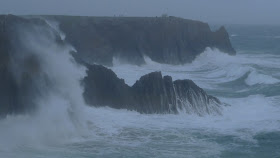A not very good picture of Iain (he can just be made out in Blue) on the first pitch.
Last Thursday (27th) myself and Iain Small had a wee wander up the Ben. Iain fancied trying a new route on the buttress left of Italian climb. Given the good forecast we were quite surprised when it started snowing on the walk in. After a cup of tea or two (an essential part of the day when climbing with Iain) and a blether with people staying there and some friends who turned up, the weather had cleared up a bit. Wandering up into the Ciste there was not too much fresh snow about, and after gearing up by a big boulder we got to the base of the route without too much trouble.
Iain leading the second pitch, during a brief clear period.
I was belayed roughly below Italian climb, and at first I enjoyed watching the way the spindrift danced up and down the gully, the patterns cause the the opposing forces and gravity and the up draft. At first the fresh snow quantities were quite small, and it did not feel too threatening. However, as time went on and the snow got heavier, the spindrift avalanches got bigger, and I started to get a bad feeling. It all started to get a bit too reminiscent of events of almost 12 years ago when, young and foolish, I had stood at the bottom of a gully watching the spindrift dancing down wards. I was just about to walk away when the whole slope above the gully released naturally. I had time to take a couple of steps before hundred of tonnes of snow hit me at high speed, and I rag dolled downwards in the midst of the avalanche. I had been lucky that day, and limped away, a badly sprained ankle being my only injury.
What it was like most of the time.
Iain stepped back down, and launched across the right wall of the corner and soon was on some ledges. The original plan had been to regain the corner above the overlap, but that looked even harder and bolder than what had gone before. Therefore he stepped right to gain Rogues Rib, a route that he had climbed last winter, and quickly scampered up that for about 20 meters to a big ledge. By this time the snow had eased, and I managed to second about half the pitch before I needed to get the head torch out. Above that Rogues Rib continued up onto the crest of Tower Ridge. However, given the darkness, and the requirment to get down safely to our bags which were near the base of the route we decided to abseil off. Abseiling off after the hard climbing always seems slightly disapointing to me, but given the conditions it was the best thing to do. One long abseil took us into Italian route, and then another to the base of the route. We wallowed around in deep powder, staying on the rope as long as possible until a quick traverse took us back to flat ground, our bags and what felt like safety.
Setting up the abseil at the top of the route.
















































